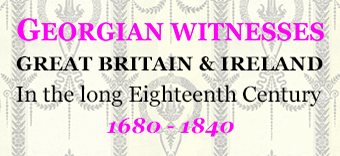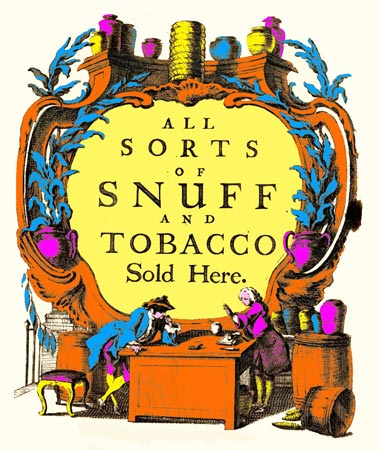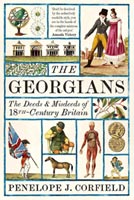Georgian Witnesses
5 / GEORGIAN DAILY LIFE, CELEBRATED IN DIARIES AND IN SPECIAL VENUES LINKED WITH DOMESTIC CONSUMPTION
Diaries are great illuminators of the mundane, turning dross into gold: and Britain in the long eighteenth century produced many exceptional diarists, some being already justly famous; others newly discovered. Here are nine daily chronicles (excluding other fascinating diaries which specialise as political commentaries, spiritual journals, and travel records), listed chronologically by diarist’s birthdate:
5.1 John Evelyn (1620 – 1706), writer, gardener and memorialist. Diary available in six volumes, ed. E.S. de Beer (Oxford, 1959), subsequently reprinted (Oxford 2000).
5.2 Samuel Pepys (1633 – 1702), naval administrator, MP, and unbuttoned diarist (in code). Diary available in nine volumes, plus a companion volume and an index, ed. R. Lathan and W. Matthews (1970 – 83).
5.3 Thomas Turner (1729 – 93), shopkeeper in East Hoathly, Sussex. The Diary of Thomas Turner, 1754 – 65, ed. D. Vaisey (Oxford, 1985).
5.4 Mary Hardy (1733 – 1809), diarist and working wife of a Norfolk farmer and brewer. Available as The Diary of Mary Hardy, 1773 – 1809, 4 vols, ed. M. Bird (2013), plus The Remaining Diary of Mary Hardy, 1773 – 1809, ed. M. Bird (2013).
5.5 James Boswell (1740 – 95), Scottish lawyer, biographer and diarist. Letters and journals published in thirteen volumes, from Boswell’s London Journal, 1762 – 3, ed. F.A. Pottle (1951); to Boswell: The Great Biographer. 1789 – 95, ed. M.K. Danziger and F. Brady (1989).
5.6 Parson James Woodforde (1740 – 1803), Norfolk clergyman and diarist. Classic edition The Diary of a Country Parson, 5 vols, ed. J. Beresford (1924 – 31); also selections in The Diary of a Country Parson: James Woodforde, ed. D. Hughes (1992).
5.7 Joseph Farington (1747-1821), landscape painter and diarist. The Diary of Joseph Farington, 17 vols (1978-98), ed. K. Garlick and others.
5.8 Frances ‘Fanny’ Burney, later Mme d’Arblay (1752 – 1840), novelist and diarist. The Early Journals and Letters of Fanny Burney, 1768-86, 5 vols (1988 – ), The Court Journals and Letters of Fanny Burney, 1786-91, 6 vols (2011 – ) and The Journals and Letters of Frances Burney, 1791 – 1840, 12 vols (1972 – ),
sundry editors.
5.9 William Cobbett (1763 – 1835), campaigning journalist and publicist. His Rural Rides were not technically kept as a private diary, but his record of his Travels around England was based upon daily entries in his journal and it contains an account of daily events plus the author’s pungent views, just as do the most informative diaries: see W. Cobbett, Rural Rides, ed. I. Dyck (London, Folio Society, 2010).
GLOBALISING TASTES IN DRINK & DAILY CONSUMPTION IN THE EIGHTEENTH-CENTURY: SIX PLACES TO VISIT
5.10 Glenturret Whisky Distillery (first licensed 1775), The Hosh, Creiff, Perthshire PH74HA: this business may have been operating illegally before it gained in 1775 an official license to provide and sell whisky – making it one of Scotland’s oldest whisky distilleries, although there are other contenders for the title. Glenturret still uses classical methods of hand-mashing the malted barley, which is then distilled, using the soft, pure waters of Loch Turret, to produce high-quality malt whiskies. This type of drink, which began as a popular favourite in Scotland, has over time gained global markets, aided by the Scottish population diaspora and also by the versatility of distillers, now in many different countries, producing Bourbons, whiskeys and rye (coming under the general category of whisky), and all in a great range of subtle flavours.
5.11 Taylor’s Port Cellars (business founded 1692), Vila Nova de Gaia, across the Douro River from Porto, Portugal: this business was begun by an English merchant named Job Bearsley, and by the mid-eighteenth century his commercial successors, who included the efficient Joseph Taylor, along with other leading English merchants in Porto, were trading in a specially fortified red wine, known simply as ‘port’.
This beverage became a great favourite as a smooth dessert wine in affluent English households, encouraged by low import tariffs after the Anglo-Portuguese commercial treaty of 1703. Today there is a vigorous global market for ports, including white and rosé as well as red varieties, and there are producers in many different parts of the world; but the cachet of Portuguese port remains unrivalled – and Taylor’s vintage (late bottled) ports are ranked among the best.
5.12 Appleton Estate (rum-producers since 1749), Nassau Valley, St Elizabeth parish, west-central Jamaica: this business is the oldest and best known of the island’s sugar-cane estates that invested in the distilling of rum from sugar-cane, and continues to cater for world-wide markets today. In the later eighteenth and early nineteenth centuries, the sugar-cane estates, worked by an enslaved population, were deeply contentious; but, while the campaigners against slavery organised effective sugar boycotts, they dented rather than halted consumption.
In Britain, Jamaican rum was popular not only as the basis for festive rum punches but also as the daily tot of spirits allocated to sailors of all ranks in the Royal Navy – a practice that began in 1655, when Britain captured Jamaica from Spain; continued from 1740 with a watered version known as grog; and ended, after over three hundred years,
in 1970.
[The Appleton sugar factory has recently closed; but the estate remains
open for visitors]
5.13 Queen’s Lane Coffee House (est. 1654) 40 High Street, Oxford, OX1 4AP: this coffee-house was not the first to be opened in Oxford (a vanished precursor dated from 1652) but it is reported to be the oldest continuously working coffee-house in Europe. The building retains something of the traditional atmosphere (though today’s menu is much more variegated than anything offered in the seventeenth and eighteenth centuries); and the mix of students and visitors to Oxford among the coffee-shop clientele remains triumphantly authentic.
5.14 Royal Crown Derby Porcelain Company (established c.1750; moved to this site in 1875), 194 Osmaston Road, Derby DE23 8JZ, with 1750 tea-room, museum and factory tours. Britain’s industrial production was mightily stimulated by consumer demand for accessible tableware, including crockery for serving coffee and tea: this Derby-based business from the start produced top-quality porcelain, which was then enamelled and painted for fine visual impact. After visiting the works in 1773, George III was sufficiently impressed to allow the wares to be renamed as ‘Crown Derby’ (and Victoria, not to be outdone, allowed the addition of ‘Royal’ in 1890).
AND FINALLY: A REMINDER OF THE MUTABILITY OF CONSUMER TASTES
5.15 Eighteenth-Century Snuff Mills, at Morden Hall Park, Morden, Surrey SM4 5JD, now well tended by the National Trust: these mills catered for the Georgian habit of snuff-taking, which once had a great social success especially among affluent men, but has since fallen out of favour with consumers – even more rapidly than has the related habit of smoking tobacco in pipes, cigars and cigarettes.
The two wooden mills (built 1750 and 1830), powered by the River Wandle, ground tobacco leaves between two large grinding stones, and the resultant powder, often kept in decorated snuff boxes, was sniffed by snuff-takers seeking an immediate nicotine buzz. Production at this site was relatively small-scale, but rendered profitable by low costs and quick access to the huge nearby market of London.
5.16 a late addendum: consult www.georgiandiningacademy.com
for Georgian fine dining, recreated, as a commercial undertaking, at Simpsons Tavern, off Cornhill in City of London EC3V 9DR; and at other special venues, by request.




